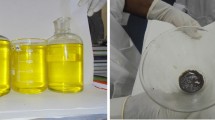Abstract
An alternate route for refining Sodium diuranate concentrate to nuclear grade product following uranium peroxide precipitation using Hydrogen peroxide (H2O2), which eliminates several cumbersome unit operations, hazardous chemicals and multiple waste streams in conventional refining process, is proposed in the reported work. Feasibility of the proposed route has been studied by conducting several experimental trials. The product obtained satisfies all impurity restrictions set by ASTM C788 for uranium nitratel pure solution intended for conversion to UO2 (uranium dioxide) fuel and provides high U recovery (> 99%). A few parametric investigations for the proposed process have also been carried out for process optimization.











Similar content being viewed by others
References
Wilson PD (1996) The nuclear fuel cycle: from ores to wastes. Oxford University Press, Oxford
Edward C, Oliver A (2000) Uranium processing: a review of current methods and technology. JOM 52(9):12–20
Sen S, Murthy TKS (1979) Ore processing and uranium refining in India. In: Proceedings of an advisory committee meeting (IAEA)—production of yellow cake and uranium fluorides
Sugai H, Munakata K, Miyachi S, Yasu S (2017) Emulsions stabilized by precipitates of zirconium and tributyl phosphate degradation products. Nucl Technol 98(2):188–195
Shabbir M, Tame KE (1974) Hydrogen peroxide precipitation of uranium. U S Bureau of mines, Washington
Gupta R, Pande VM, Pranesh SR, Chakravarty AB (2004) Study of an improved technique for precipitation of uranium from eluted solutions. Hydrometallurgy 71(3–4):429–434
Sato T (1963) Preperation of uranium peroxide hydrates. J Appl Chem 13(8):361–365
Merritt RC (1971) Extractive metallurgy of uranium. Colorado School of Mines Research Foundation, Colorado
Cotton FA, Wilkinson G (1962) Advanced inorganic chemistry—a comprehensive text. Wiley Interscience Publications, Hoboken
Smirnov AL, Skripchenko SY, Rychkov VN, Pastukhov AM, Shtutsa MG (2013) Uranium stripping from Tri-n-butyl phosphate by hydrogen peroxide. Hydrometallurgy 137:18–22
Bhowmik A, Shanmughavelu P, Dhavmani D, Agarwal A (2009) Single stage purification for uranium refining, patent corporation treaty patent PCT/IN2007/000305
Schwerdt J, Olsen A, Lusk R, Heffernan S, Klosterman M, Collins B, Martinson S, Kirkham T, Mcdonald LW (2017) Nuclear Forensics Investigation of morphological signatures in the thermal decomposition of uranyl peroxide. Talanta 176:284–292
Grenthe I, Fuger J, Konings R, Lemire R, Muller A, Wanner H (1992) Chemical thermodynamics of uranium. Elsevier North Holland imprint, Amsterdam
Yamine M, Waters D J (1980) An improved precipitation technique for recovery of uranium from its liquors. In: 8th Australian chemical engineering conference, Melbourne, Australia, pp. 129–133
ASTM standard C788–03, 2003, Standard specification for nuclear grade uranyl nitrate solution or crystals, ASTM international, Pennsylvania, USA
ASTM C1233–98, 1998. Standard practice for determining equivalent boron contents of nuclear materials, ASTM international, Pennsylvania, USA
Cahill AE, Burkhart LE (1990) Continuous precipitation of uranium with hydrogen peroxide. Metall Trans B 21(5):819–826
De Laat J, Gallard H (1999) Catalytic decomposition of hydrogen peroxide by Fe in homogeneous aqueous solution. Environ Sci Technol 33(16):2726–2732.
Kim KW, Lee KY, Baek JY, Chung YD (2015) Evaluation of the stability of precipitated uranium peroxide and its storage characteristics in solution. J Nucl Sci Technol 53:263–270
Hatcher WH, Maclauchlan DW (1938) Conductivity data of aqueous mixtures of hydrogen peroxide and nitric acid. Can J Res Section B 16(8):253–259
Acknowledgements
The authors acknowledge Bhabha Atomic Research Centre (BARC) for providing financial and support for undertaking this work.
Funding
The funding was provided by Bhabha Atomic Research Centre
Author information
Authors and Affiliations
Corresponding author
Additional information
Publisher's Note
Springer Nature remains neutral with regard to jurisdictional claims in published maps and institutional affiliations.
Rights and permissions
About this article
Cite this article
Amalraj, V.S., Tiwari, A.K., Agrawal, A. et al. Study of sodium diuranate concentrate refining using H2O2. J Radioanal Nucl Chem 331, 867–876 (2022). https://doi.org/10.1007/s10967-021-08158-0
Received:
Accepted:
Published:
Issue Date:
DOI: https://doi.org/10.1007/s10967-021-08158-0




